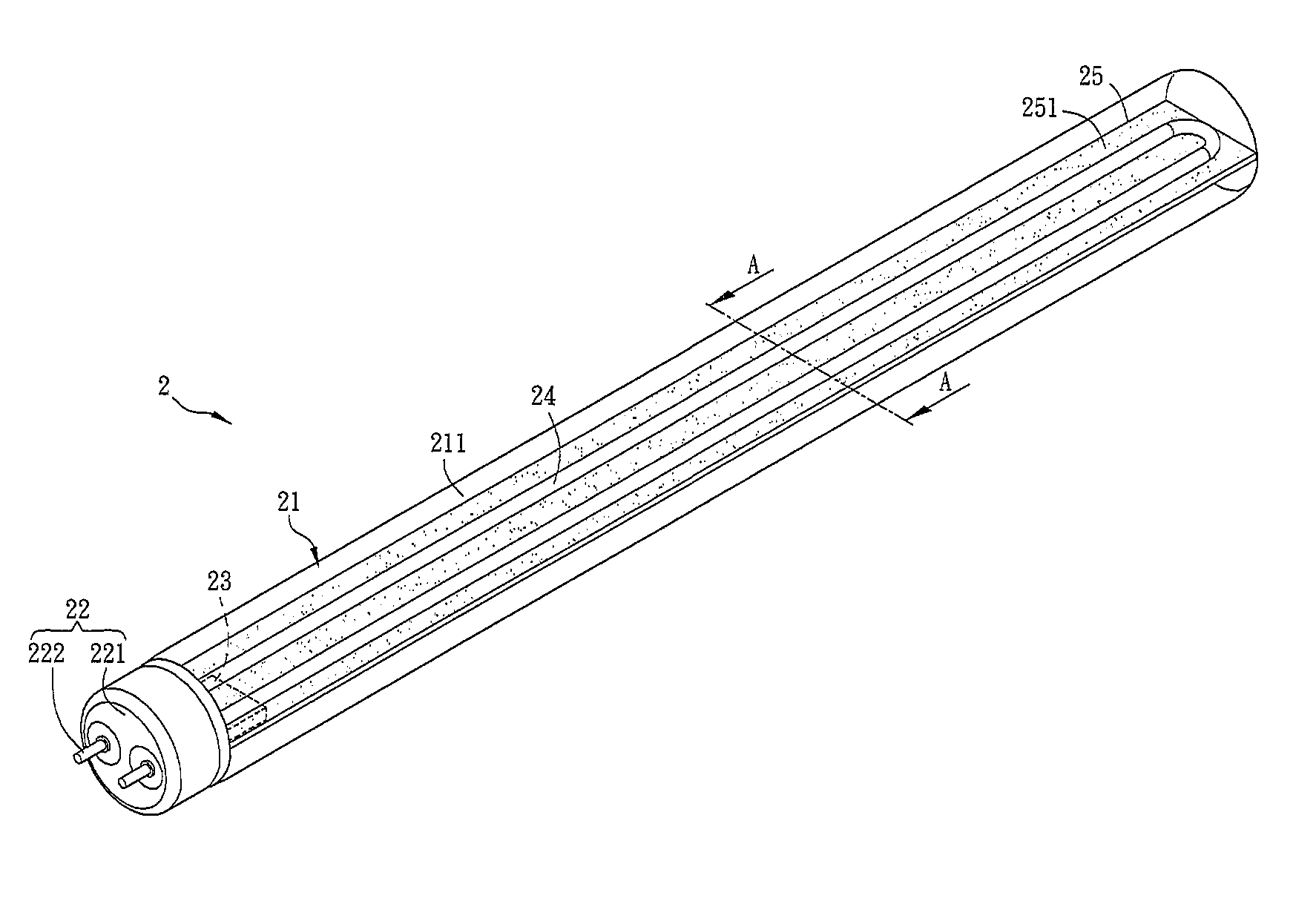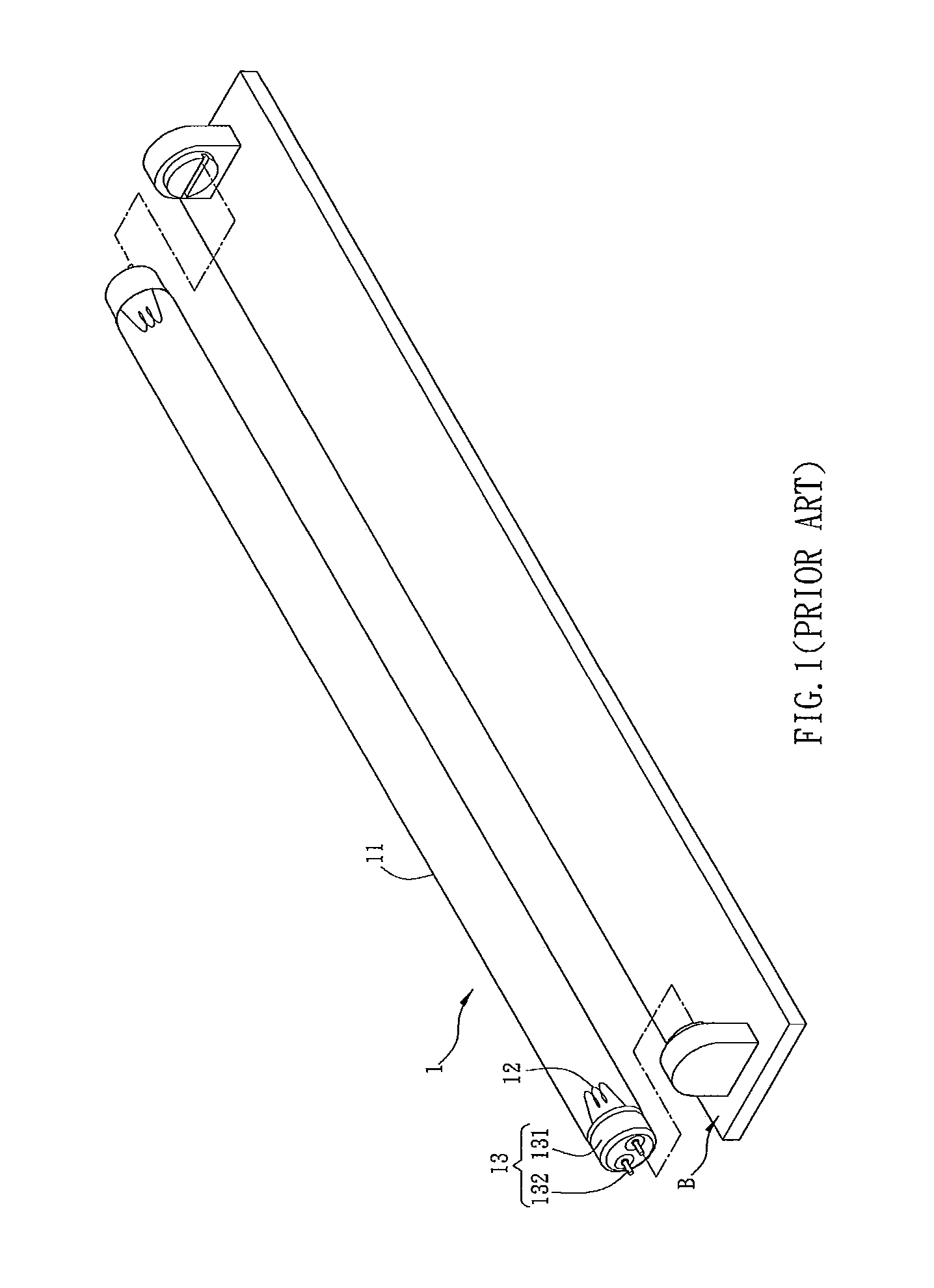Cold cathode illumination apparatus
a technology of illumination apparatus and cold cathode, which is applied in the direction of transit-tube circuit elements, cathode-ray/electron beam tube circuit elements, structural circuit elements, etc., can solve the problems of users inconvenient use and tardy lighting up, and achieve the ability of dimming, improve the efficiency of light usage, and prolong the life
- Summary
- Abstract
- Description
- Claims
- Application Information
AI Technical Summary
Benefits of technology
Problems solved by technology
Method used
Image
Examples
first embodiment
[0027]FIG. 2A is a schematic view of a cold cathode illumination apparatus 2 according the first embodiment of the invention, and FIG. 2B is a sectional diagram taken along the section A-A in FIG. 2A. Referring to FIGS. 2A and 2B, the cold cathode illumination apparatus 2 is applied with an alternative current (AC), which is, for example, the AC with 60 Hz supplied from the city power or the AC outputted by other electronic devices such as inverters, electronic ballasts and electromagnetic ballasts. To be noted, the AC compliant with high frequency, low frequency or other frequencies is applicable. Among them, the high frequency range may be between 1 KHz and 1000 KHz, and is preferably between 20 KHz and 30 KHz or between 40 KHz and 70 KHz.
[0028]The cold cathode illumination apparatus 2 includes a tube 21, at least one electrical connection element 22, a voltage transforming element 23, a CCFL 24 and a strip element 25.
[0029]At least a part of the tube 21 is light-permeable. The tu...
second embodiment
[0045]FIG. 3 shows a cold cathode illumination apparatus 3 according to the second embodiment of the invention. The main difference between the cold cathode illumination apparatus 3 and the first embodiment is that the cold cathode illumination apparatus 3 includes two electrical connection elements 32, which are disposed at two ends of the tube 31 respectively, and each electrical connection element 32 has a lamp cap 321 and two electrode pins 322. Besides, the cold cathode illumination apparatus 3 further has two linear CCFLs 34 and two strip elements 35. The CCFLs 34 are adhered to the tube 31 parallely. Each of the strip elements 35 has a Y-shaped cross-section, and is used as the supporter of the CCFL 34.
[0046]Therefore, the cold cathode illumination apparatus 3 can be directly connected to the present electronic ballast, and receive the high frequency power outputted by the electronic ballast, thereby enhancing the usage convenience and saving the cost of altering the circuit....
third embodiment
[0049]FIG. 6A is a schematic view of the cold cathode illumination apparatus 4 cooperated with the lamp base B, and FIG. 6B is a sectional view of the cold cathode illumination apparatus 4 taken along the section B-B in FIG. 6A. As shown in FIGS. 6A and 6B, the main difference between the cold cathode illumination apparatus 4 of the third embodiment and the first embodiment is that the cold cathode illumination apparatus 4 includes two electrical connection elements 42 which are disposed at two ends of the tube 41 respectively, and each electrical connection element 32 has a lamp cap 421 and two electrode pins 422. Besides, the cold cathode illumination apparatus 4 can further have at least one circuit board 46 and at least one supporting element 47.
[0050]The circuit board 46 is disposed in the tube 41, and located at the side opposite to the CCFL 44, for example. Of course, the circuit board 46 can be disposed at the same side as the CCFL 44. The tube 41 can have a light-permeable ...
PUM
 Login to View More
Login to View More Abstract
Description
Claims
Application Information
 Login to View More
Login to View More - R&D
- Intellectual Property
- Life Sciences
- Materials
- Tech Scout
- Unparalleled Data Quality
- Higher Quality Content
- 60% Fewer Hallucinations
Browse by: Latest US Patents, China's latest patents, Technical Efficacy Thesaurus, Application Domain, Technology Topic, Popular Technical Reports.
© 2025 PatSnap. All rights reserved.Legal|Privacy policy|Modern Slavery Act Transparency Statement|Sitemap|About US| Contact US: help@patsnap.com



